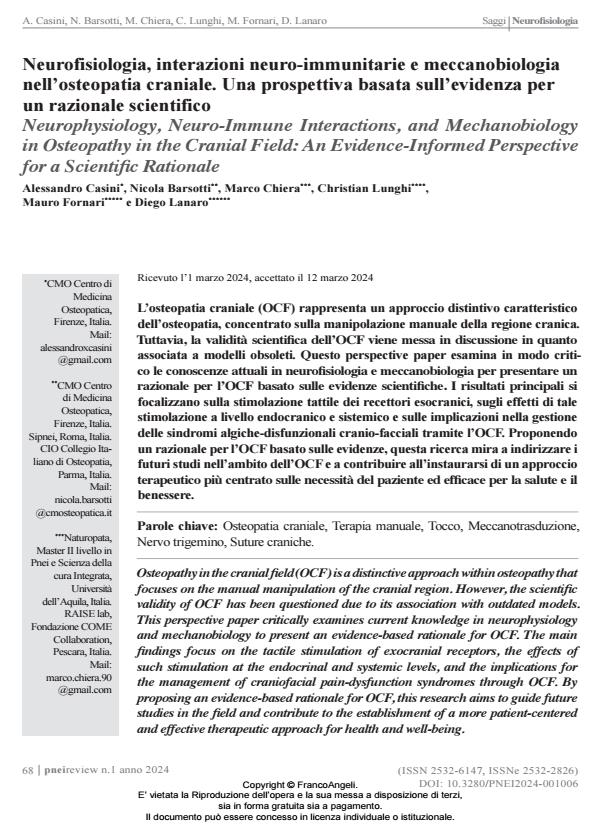Neurofisiologia, interazioni neuro-immunitarie e meccanobiologia nell’osteopatia craniale. Una prospettiva basata sull’evidenza per un razionale scientifico
Titolo Rivista PNEI REVIEW
Autori/Curatori Alessandro Casini, Nicola Barsotti, Marco Chiera, Christian Lunghi, Mauro Fornari, Diego Lanaro
Anno di pubblicazione 2024 Fascicolo 2024/1
Lingua Italiano Numero pagine 14 P. 68-81 Dimensione file 1137 KB
DOI 10.3280/PNEI2024-001006
Il DOI è il codice a barre della proprietà intellettuale: per saperne di più
clicca qui
Qui sotto puoi vedere in anteprima la prima pagina di questo articolo.
Se questo articolo ti interessa, lo puoi acquistare (e scaricare in formato pdf) seguendo le facili indicazioni per acquistare il download credit. Acquista Download Credits per scaricare questo Articolo in formato PDF

FrancoAngeli è membro della Publishers International Linking Association, Inc (PILA)associazione indipendente e non profit per facilitare (attraverso i servizi tecnologici implementati da CrossRef.org) l’accesso degli studiosi ai contenuti digitali nelle pubblicazioni professionali e scientifiche
L’osteopatia craniale (OCF) rappresenta un approccio distintivo caratteristico dell’osteopatia, concentrato sulla manipolazione manuale della regione cranica. Tuttavia, la validità scienti?ca dell’OCF viene messa in discussione in quanto associata a modelli obsoleti. Questo perspective paper esamina in modo critico le conoscenze attuali in neuro?siologia e meccanobiologia per presentare un razionale per l’OCF basato sulle evidenze scienti?che. I risultati principali si focalizzano sulla stimolazione tattile dei recettori esocranici, sugli effetti di tale stimolazione a livello endocranico e sistemico e sulle implicazioni nella gestione delle sindromi algiche-disfunzionali cranio-facciali tramite l’OCF. Proponendo un razionale per l’OCF basato sulle evidenze, questa ricerca mira a indirizzare i futuri studi nell’ambito dell’OCF e a contribuire all’instaurarsi di un approccio terapeutico più centrato sulle necessità del paziente ed ef?cace per la salute e il benessere.�
Parole chiave:Osteopatia craniale, Terapia manuale, Tocco, Meccanotrasduzione, Nervo trigemino, Suture craniche.
Alessandro Casini, Nicola Barsotti, Marco Chiera, Christian Lunghi, Mauro Fornari, Diego Lanaro, Neurofisiologia, interazioni neuro-immunitarie e meccanobiologia nell’osteopatia craniale. Una prospettiva basata sull’evidenza per un razionale scientifico in "PNEI REVIEW" 1/2024, pp 68-81, DOI: 10.3280/PNEI2024-001006